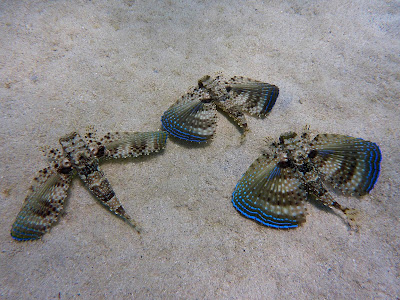Life at the Sandy Bottom
Sedimentary habitats are exactly what they sound like, areas of sandy, or muddy marine habitats that result from settlements of sand and sediment particulates in locations of lower water movement. When we think of sandy habitats, we imagine shallow lagoonal areas along the coastline, which include areas along the bases of coral reefs in deep harbour bays such as Maracas Bay, Charlotteville and Scarborough. These types of habitats also extend to great depths beyond the continental shelf. Although these habitats may not be the postcards of marine biodiversity, the varying environments in which they are found make them quite diverse in terms of the communities that can live there. As sedimentary habitats are so extensive and rarely accessible, many of these places are underexplored especially in deeper locations; and to this today, the exploration of these habitats still results in the discovery of new species.
 |
| Flying gurnards flash their colours as they cruise over a shallow sandy bed. Photo by Anjani Ganase |
What do we find?
Sedimentary habitats support marine creatures capable of living within the substrate by burrowing holes or are small enough to move between the sand particles away from predation, and include small critters, such as crabs, sea stars, clams, conch, polychaete worms and fish. Larger predators, such as stingrays, skates, sand sharks, fish and octopuses, on the other hand, forage the surfaces of these sediment beds for prey. When I used to swim laps along Grange Bay, I remember coming across clouds of sand being disturbed. As I approached the cloud, usually a stingray might be seen digging into the sand for burrowed prey. As the stingrays stir up the sediment, food is released and often a school of fish would be seen in the wake of the stingray scavenging leftovers. Even less is known about the microfauna that live in the tiny spaces between sand particles in their own microbial world, or the impacts these microbes have on the surrounding ecosystem.
 |
| Flounders are ambush predators that camouflage with the sandy substrate. Photo by Anjani Ganase |
How can they live there?
The communities of organisms that live in these habitats can be very diverse. In shallow habitats, frequent disturbances such as storm debris make it difficult for permanent establishment of sessile communities because of constant shifting particulates. As a result, the residents tend to be armoured with hard outer shells or tough exoskeletons, adapted to be able to withstand being buried, and abraded by sand particles in these dynamic environments, which also act as their shields against predation. In areas of minimal water movement, poor circulation means that organisms may also have to adapt to low oxygen conditions by having smaller body size, or by living closer to the surface of sand. The feeding modes of these marine organisms also change as the environmental conditions of these sediment basins vary. In locations with constant water movement, you’ll find suspension feeders such as brittle stars and Cnidaria, while deposit feeders – crabs, urchins and molluscs – occur in calmer areas foraging the detritus that covers surfaces. In deeper locations beyond the reaches of light, the communities rely on other sources of food, such as from chemical energy at hydrothermal thermal vents or food that sinks from the surface, such as carcasses from whales and other megafauna.
What is the importance?
Much of our commercially important seafood – lobster, conch, crab, scallops and shrimp – come from sediment bottom habitats. In the Bahamas, the Queen conch and the spiny lobster are national dishes, while shrimp is popular throughout the region and globally. Apart from the consumption of this marine life, there is an attraction for recreational exploration of these habitats and the unique organisms that live there. In Southeast Asia, muck diving – diving along sediment bottoms, mostly composed of black volcanic sand – allows visitors to explore and encounter unusual marine life including the famous wonderpus octopus, a brightly banded octopus, as well as nudibranchs and disguised seahorses and frogfish and other assortment of critters. In the Caribbean, we often find flying gurnards, stingrays, and nurse sharks cruising the sandy bottoms.
However these habitats are important for other purposes. Microorganisms that live in the sediment contribute to sediment stability as they establish their homes, by making burrows or by binding sand particles together, often done by sponge species. This results in the trapping and consolidation of carbon and other materials. Organisms that remove suspended particulates from of the water column as they feed also aid in clarifying the water column. This material may include pollutants, which are then stored in the sediment, as well as in the tissues of organisms through consumption. Past studies have looked at the composition of pollutants in the tissues of organisms, such as filter feeding mussels, to determine the extent of human disturbances. Overall, the sedimentary microfauna play a significant role in the cycling of carbon, and other elements, such as nitrogen and sulphur.
 |
| Lizardfish bury themselves in the sand and wait for prey. Photo by Anjani Ganase |
Threats to sediment habitats
 |
| Sedimentary habitats appear to be barren at first glance but with a closer look, one will discover an array of marine life in these habitats. Photo by Anjani Ganase |
References
Thompson, R.C., Olsen, Y., Mitchell, R.P., Davis, A., Rowland, S.J., John, A.W.G., McGonigle, D., Russell, A.E., Lost at Sea: Where Is All the Plastic? Science, 2004: 838.
Snelgrove, P. V. R., Getting to the Bottom of Marine Biodiversity: Sedimentary Habitats, BioScience, 1999: Vol. 49 No. 2, 129-138.


